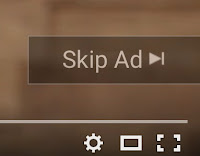Yesterday, I wanted to cook stuffed artichokes for dinner. So, I searched Google for a video and found this on YouTube: "ITALIAN STUFFED ARTICHOKES - SICILIAN STYLE - EASTER DINER RECIPE."
Before the cooking lesson started, there was an in-video ad for an Rx drug, the name of which I can't recall right now. No matter. After 15 seconds or so I realized I could click on "Skip Ad" and not hear any more of the side effects, aka FDA-required Important Safety Information (ISI), "major statement," and "Fair Balance" stuff that is usually crammed into Direct-to-Consumer (DTC) TV ads after about 20 or 30 seconds.
Ruth Day of Duke University once said of print and TV DTC drug ads (here): “Risk information is physically present but functionally absent.” This accurately describes what's happening in skippable in-video DTC ads on Youtube.
According to YouTube Help, there are two versions of in-video ads: (1) skippable ads like the one I saw, and (2) non-skippable ads.
It seems that pharma uses only the former, not the latter. Is this acceptable?
When space or time is limited -- as in TV DTC ads -- the drug industry is concerned that the "major statement" of risks -- as currently implemented in DTC ads -- is often too long and "may result in reduced consumer comprehension, minimization of important risk information and, potentially, therapeutic noncompliance due to fear of side effects."
It seems that skippable in-video DTC ads on YouTube conveniently solves this problem.
I don't recall seeing any drug DTC in-video ad on YouTube that was non-skippable. Of course, I prefer the skippable ones, but some advertisers want you to see the entire ad. Shouldn't pharma also want viewers to see the entire ad, including the important safety information?
What do you think? Please answer my informational poll below.
Should (will) the FDA issue guidance about which type is acceptable from a regulatory point of view? I'll pose that question to someone at the FDA and see if I get a response.


I find this interesting from a different angle. Given that I've been getting plenty of mis-aimed YouTube commercials of late (in languages and scripts I don't readily understand, plus for elections I'm not allowed to vote in in countries I don't reside in...) I wonder if YouTube ensures that Rx commercials aren't sent to people in countries where DTC ads for Rx drugs are prohibited...
ReplyDeleteInteresting!
ReplyDelete